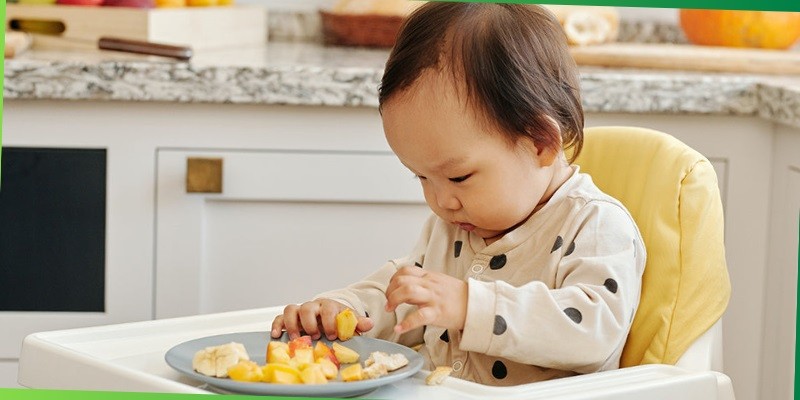Introducing solid foods to your baby is a milestone moment. It’s exciting but also a bit confusing for many parents.
As your baby grows, you’ll notice changes in their behavior and habits. These changes can signal that your baby is ready for something more than milk. Understanding these signs can make the transition smoother for both you and your little one.
In this blog post, we will discuss the key indicators that show your baby might be ready for solid foods. Recognizing these signs early can help you make informed decisions about your baby’s diet, ensuring they get the right nutrients for healthy growth and development. Let’s explore these signs together and make your baby’s journey to solid foods an enjoyable experience.
Physical Development
Babies show readiness for solid foods through various physical signs. Sitting up without support and showing interest in food are key indicators. Another sign is the ability to hold their head steady.
### Physical Development
Watching your baby grow is an incredible journey. One of the milestones that signal they might be ready for solid foods is their physical development. Here are two key signs to look out for:
Head And Neck Control
Strong head and neck control is crucial. Your baby should be able to hold their head steady and upright. This control helps them swallow food safely without choking.
I remember my little one bobbing their head like a curious bird before they finally mastered this skill. It was a clear sign they were gearing up for the next big step.
Does your baby show this kind of control? Watch for it during playtime or while they’re sitting in your lap.
Sitting Up Unassisted
Can your baby sit up without support? This is another important indicator.
Sitting up unassisted means your baby has the muscle strength and balance needed to eat solids. It’s also safer, reducing the risk of choking since their airway is more aligned.
Think about those moments when your baby tries to sit up during bath time or while playing with toys. If they can sit up on their own, they might be ready to explore new textures and tastes.
Are you noticing these signs? If yes, it might be time to introduce your baby to the exciting world of solid foods!

Credit: tidytotusa.com
Behavioral Signs
As your baby grows, they show various signs of readiness for solid foods. Observing these signs helps you decide the right time to introduce solids. Behavioral signs are among the most noticeable indicators. These changes in behavior are clear hints that your baby might be ready to explore new textures and tastes.
Increased Appetite
One of the first signs is an increased appetite. Your baby may seem hungry even after regular breastfeeding or formula feeding. They might demand more frequent feedings. You may also notice them waking up more often during the night for extra feeds. These signs suggest that milk alone may not be enough to satisfy their hunger.
Interest In Food
Your baby might start showing interest in the foods you eat. They may watch you intently during meals. You could see them reaching out for your food or trying to grab it. Their curiosity about food is a strong sign of readiness. They might also mimic chewing motions with their mouth. This interest indicates their willingness to try new foods.
Oral Skills
As your baby grows, their oral skills develop. These skills are essential for starting solid foods. Watch for specific signs that indicate your baby is ready. Let’s explore these signs under the headings below.
Chewing Motions
Observe your baby’s mouth movements. They may start making chewing motions. This is a good sign. Babies mimic eating even without food. These motions help them learn how to chew. Chewing motions show their readiness for solid foods.
Loss Of Tongue-thrust Reflex
The tongue-thrust reflex helps babies avoid choking. It makes them push food out of their mouths. Around six months, this reflex fades. A baby who keeps food in their mouth is ready for solids. This loss is a major sign of readiness. Your baby can now handle new textures and tastes.

Credit: tinyeaters.co
Frequently Asked Questions
What Are The 3 Clear Signs A Baby Is Ready For Their First Solid Foods?
1. Baby can sit up with minimal support. 2. Baby shows interest in food and reaches for it. 3. Baby can swallow food without pushing it out.
What Are The 4 Signs Babies Show Indicating Their Readiness For Solids?
Babies show readiness for solids by sitting up without support. They show interest in food. They can swallow easily. They have good head and neck control.
How To Know When Baby Is Ready To Eat Solids?
Babies are ready for solids when they can sit up, show interest in food, and have good head control. They also lose the tongue-thrust reflex and can move food to the back of their mouth. Usually, this happens around 6 months old.
Always consult your pediatrician first.
What Are The Signs That The Baby Is Ready To Eat?
The baby shows readiness to eat by sitting up with support, showing interest in food, and reaching for it. They can also move food to their mouth and have good head control.
Conclusion
Recognizing your baby’s readiness for solid foods is crucial. Watch for key signs. Your baby might show interest in your meals. They may have better control of their head and neck. Sitting up without help is another good indicator. Introducing solids can be exciting.
Always consult your pediatrician for advice. Trust your instincts. Every baby is different. Enjoy this new milestone in your baby’s journey.

